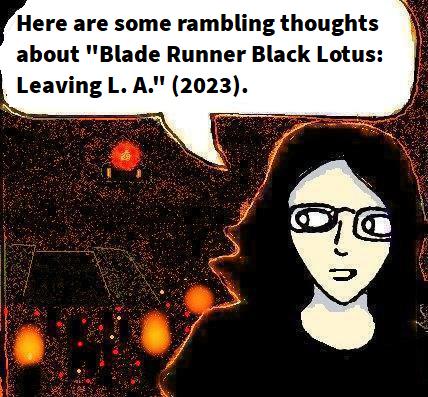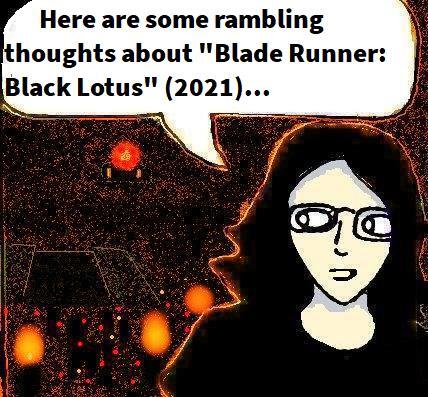
Well, at the time of writing, it’s Christmas day last year and I’ve just finished reading “Blade Runner: Black Lotus – Leaving L.A.” (2023) by Nancy A. Collins, Enid Balam et al. This isn’t really a full review of it, but more some rambling thoughts written on a lazy afternoon because it seems like my plan to take a day off from writing articles has failed miserably…
This article may contain SPOILERS.
Picking up after the “Blade Runner: Black Lotus” TV series, the comic follows Elle travelling through the desert outside Los Angeles. Naturally, she runs into trouble and quickly finds herself in the middle of a war between a fracking company and a desert commune….
One of the interesting things about this comic is that, like the TV series it is based on, it actually “works” if you don’t try to compare it to the “Blade Runner” films. On paper, the comic might sound painfully generic – with lots of mindless action sequences, cartoonish villainy/heroic heroes etc… But the best way I can describe it is that it’s like a fun late 1990s sci-fi action movie you might have stumbled across on late-night TV during the 2000s (but more on that later...) paired with an old paperback thriller novel.
And, weirdly, this is actually sort of perfect for the comic. Unlike the slower-paced and more cerebral “Blade Runner” films, the “Blade Runner: Black Lotus” TV series is meant to be a more streamlined, fast-paced action series. And the comic fits perfectly into this tradition. It’s a fun, mindless “turn your brain off and enjoy the fireworks” action genre story where Elle gets to fight some villains and save some villagers.
Like a thriller novel, everything is turned up to eleven – the villains are cartoonishly evil and, aside from a token angst-ridden backstory for Miguel (an ex-Blade Runner), the “good guys” are almost cartoonishly “good” too. It’s a story as old as the ages, and it works because it’s entertaining.
Lest anyone think that this is a bad review, one of the cool things about this comic is that they actually got Nancy A. Collins to write it. Although I’ve only read one of her older 1980s vampire novels, you can definitely tell that the comic is by the same author. There’s an edginess to it which reminded me a bit of “Sunglasses After Dark” 🙂 It’s gorier, darker and more brutal than the TV series and it definitely has more of a thriller novel type atmosphere to it as well 🙂
It’s also interesting to see whether the “Blade Runner” universe actually works outside of the neon-drenched cities that it is famous for. Of course, “Blade Runner 2049” (2017) included some scenes set in wastelands and the 1960s Phillip K. Dick novel that the original “Blade Runner” film is based on had more of a post-apocalyptic vibe as well as references to deserts (in the “Empathy box” scenes). And whilst there are references to replicants and the Tyrell/Wallace corporation, the comic sort of feels more like its own thing. It reminded me a bit of the “Fallout” series, or – perhaps more aptly – Paul W. S. Anderson’s 1998 sci-fi action film “Soldier”. And, as soon as I realised this, the comic made perfect sense.
Famously, “Soldier” (1998) was meant to be something of an unofficial spin-off from “Blade Runner” (1982). And, whilst the characters, setting and story and mood are subtly different – the general theme of an “enhanced” character defending a desert village is something that both the comic and film have in common. I don’t know if this film was actually an influence on the comic, but I’d be very surprised if it wasn’t.
The art by Enid Balam (et al) is pretty cool as well 🙂 Whilst Balam has his own “style”, it also isn’t too different to the style of artwork that I’ve seen in other “Blade Runner” comics too. Given the desert setting, most of the detail tends to be focused more on the characters than the backgrounds. I’m not sure if this was an intentional artistic choice in order to keep the pacing fast and the emphasis on the characters, or whether it was because the story was originally published as a four-issue comic and this helped the art team to save time and/or meet deadlines.
Still, whilst the cyberpunk art on the front and back covers (by Junggeun Yoon and Creees Lee, respectively) is seriously cool-looking, the locations are a world apart from what the actual contents of the comic look like. Again, it’s really cool-looking cyberpunk art, and I get why they probably chose to use this sort of cover art because of the “Blade Runner” name and to grab the reader’s attention, but it is very different to the actual comic (which is almost more like a sci-fi western...).
So, yes, it’s actually a better comic than I first thought. Again, reading it is like stumbling across a fun late-night 1990s sci-fi action movie on TV during the 2000s. It is also very emphatically a “Blade Runner: Black Lotus” comic rather than a “Blade Runner” comic, with a “turned up to eleven” version of the sort of focused, action-packed story you’d expect from this TV series – but with the extra “edge” that Nancy A. Collins can provide. And, whilst this comic doesn’t exactly reinvent the wheel, it is aiming to be entertaining rather than “high-brow”. And it succeeds at this.
—————–
Anyway, I hope that this was interesting 🙂
